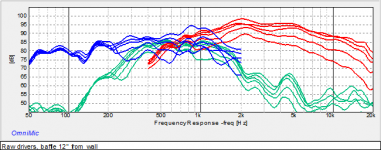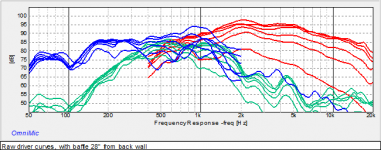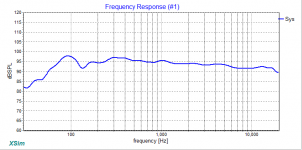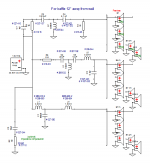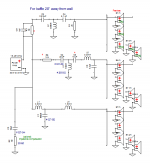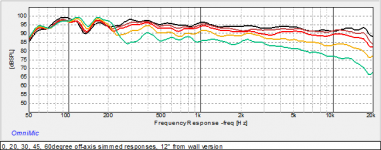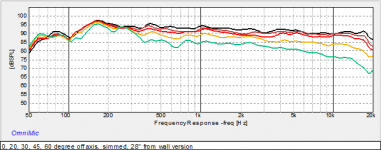is there a goal behind that instead making a narower tower (else than putting the cabinets on shelves near a wall) ?
I'm not sure I understand your question, but a narrow tower can't have much directivity. It takes horizontal physical dimensions on the order of a wavelength to have horizontal directivity at a given frequency. (Not counting dipoles or the like, that is, which get directivity via a backwave).
An overall goal of the speakers is to make them look as small as I can. Wife doesn't want, in our small living-room, the monster-size boxes or panels I would otherwise tend to make!
But the shelf-ported reflex versions will have to be much deeper (need the box volume) to avoid making the height and width too large).
WAF & directivity are both good targetts !
Yes it was the sense of my question, because we see most of the times narows front bafle but for the OBs... And I noticed it was already what you've made with your main speaker ! As it's a sota engineering I can't believe it was not about a sounding question (and if we can hunt a bird with two stones and content our wives, it's good as well )
Yes it was the sense of my question, because we see most of the times narows front bafle but for the OBs... And I noticed it was already what you've made with your main speaker ! As it's a sota engineering I can't believe it was not about a sounding question (and if we can hunt a bird with two stones and content our wives, it's good as well )
Progress at a crawl, but still forward
I had to take a hiatus from this to finish some software and then to do some construction at the back of the house (a project for my wife and our pets). And the past few days, I have a flu (even got a ride in an ambulance, thought it was a heart attack!), but that lets me sit in a chair with time to write up what progress has happened.
The software work did help this effort, it turns out, as i was able to modify OmniMic so that it gets better windowed response measurement at below the frequency limit of the window. In previous versions, it was a weighted blend of several window lengths into one trace. Now it is more like the MLSSA sliding window (I forget what they call it), in that it always emphasizes the earlier-in-time portions of the impulse response. That gives a better approximation of the responses that you'd get in a reflection-free environment, like outdoors. The curves do look more like what I was seeing last time I was able to make outdoor measurements.
I took two more sets of responses, of each driver (or array) individually, at a variety of offset angles. And the "combined" measurements of pairs (a way of getting relative time domain data precise -- lots written on that elsewhere). I did this with the speaker at two positions relative to the back wall, 12" out and 28" out, for two likely positioning of the speakers. Here are the curves (0, 20, 30, 45, 60, 90 degrees). The 12" from wall seems to be giving me potential for some more directivity extension down to 300ish Hz for way off-axis (not sure why).
edit: looks like the 12" from wall pic is missing the 90 degree curves (which I'm not actually designing for anyway).
I had to take a hiatus from this to finish some software and then to do some construction at the back of the house (a project for my wife and our pets). And the past few days, I have a flu (even got a ride in an ambulance, thought it was a heart attack!), but that lets me sit in a chair with time to write up what progress has happened.
The software work did help this effort, it turns out, as i was able to modify OmniMic so that it gets better windowed response measurement at below the frequency limit of the window. In previous versions, it was a weighted blend of several window lengths into one trace. Now it is more like the MLSSA sliding window (I forget what they call it), in that it always emphasizes the earlier-in-time portions of the impulse response. That gives a better approximation of the responses that you'd get in a reflection-free environment, like outdoors. The curves do look more like what I was seeing last time I was able to make outdoor measurements.
I took two more sets of responses, of each driver (or array) individually, at a variety of offset angles. And the "combined" measurements of pairs (a way of getting relative time domain data precise -- lots written on that elsewhere). I did this with the speaker at two positions relative to the back wall, 12" out and 28" out, for two likely positioning of the speakers. Here are the curves (0, 20, 30, 45, 60, 90 degrees). The 12" from wall seems to be giving me potential for some more directivity extension down to 300ish Hz for way off-axis (not sure why).
edit: looks like the 12" from wall pic is missing the 90 degree curves (which I'm not actually designing for anyway).
Attachments
Last edited:
Notice in the curves above that the woofers actually might be able to get up to the tweeter's low end alone, except that they would go all wobbly off-axis (notice how wild the curves get up around 750Hz or so. The midrange is much better behaved there, and plays low enough to do the waveguide/array fade-in trick.
Here are the projected curves with a designed crossover for each, hope these still hold when I do get to do some better free-field measurements. (BTW -- the levels on these aren't accurate, I wasn't keeping track of the drive voltage when the curves were taken).
Yes, I already went ahead and ordered parts (including bigger core inductors, expensive unfortunately) for these designs. Also another set of drivers to make the shelf-ported version when I get done with house projects and bothering the EMTs.
Here are the projected curves with a designed crossover for each, hope these still hold when I do get to do some better free-field measurements. (BTW -- the levels on these aren't accurate, I wasn't keeping track of the drive voltage when the curves were taken).
Yes, I already went ahead and ordered parts (including bigger core inductors, expensive unfortunately) for these designs. Also another set of drivers to make the shelf-ported version when I get done with house projects and bothering the EMTs.
Attachments
Last edited:
There's now a downward slope of a few dB added starting at around 1kHz, to bring the brightness down a shade (tuned to taste, rather than ruler-flat..... gotta work well with recordings that exist!).
Here are some (simulated) off-axis curve families for the 12" from wall and the 28" from wall crossover versions. Again, the curves for these were taken in a not-very-open basement room, so there may well be some further tweaking done after crossovers are built and the whole mess can go outside to bother the neighborhood with best-quality measurements.
I'm HOPING that a redesign isn't needed then (like after the last time I was outside, and discovered that I had totally messed up the vertical patterns!). No vertical patterns simulated here, because it turns out the trick to getting the vertical looking decent in this design layout is to have the phase angles track decently over the handoff from midrange to woofer (and it does in these new designs).
Wish the crossovers were more simple, however there is the advantage that the drivers are better contained in their bandwidths which should keep it sounding cleaner. I do hate it when the costs of crossover inductors starts to approach cost of the drivers!
Here are some (simulated) off-axis curve families for the 12" from wall and the 28" from wall crossover versions. Again, the curves for these were taken in a not-very-open basement room, so there may well be some further tweaking done after crossovers are built and the whole mess can go outside to bother the neighborhood with best-quality measurements.
I'm HOPING that a redesign isn't needed then (like after the last time I was outside, and discovered that I had totally messed up the vertical patterns!). No vertical patterns simulated here, because it turns out the trick to getting the vertical looking decent in this design layout is to have the phase angles track decently over the handoff from midrange to woofer (and it does in these new designs).
Wish the crossovers were more simple, however there is the advantage that the drivers are better contained in their bandwidths which should keep it sounding cleaner. I do hate it when the costs of crossover inductors starts to approach cost of the drivers!
Attachments
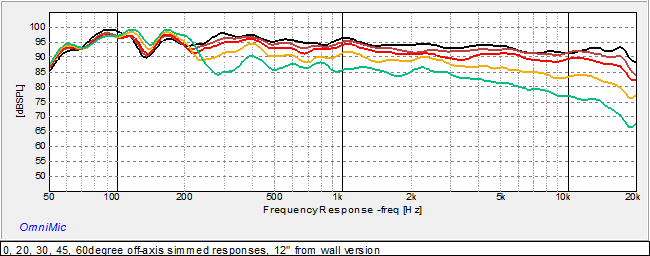
Those predicted responses look great. Nice work. Hope you are better now. Flu can be serious stuff. Especially when it becomes pneumonia.
Are you the author of Omnimic software? Cool!
I just replaced some bad AC condenser motors and will pull them apart hoping to scavenge enameled magnet wire. Rolling one's own inductors is one way to deal with their cost, which I agree, is annoying when approaches cost of drivers.
Great,
How far are the side walls in these measurements please ?
Do you like what you listen to with these new drivers (different equilibrium than yourr main or do you miss the bass to a better idea ?)
How far are the side walls in these measurements please ?
Do you like what you listen to with these new drivers (different equilibrium than yourr main or do you miss the bass to a better idea ?)
Hi bwaslo,
Nice build you have going here. The form factor, passive house curve and extended directivity are all neat features!
Can you please provide more information about how the slotted-woofers extend the horizontal directivity? Also, what would be the low frequency directivity limit using the slotted-woofer technique?
Regards, Mark
Nice build you have going here. The form factor, passive house curve and extended directivity are all neat features!
Can you please provide more information about how the slotted-woofers extend the horizontal directivity? Also, what would be the low frequency directivity limit using the slotted-woofer technique?
Regards, Mark
Great,
How far are the side walls in these measurements please ?
Do you like what you listen to with these new drivers (different equilibrium than yourr main or do you miss the bass to a better idea ?)
Hi Eldam,
The closest side wall is about 12 feet away, but the room is cluttered with easy chairs, a scandinavian sofa, boxes, diffusors, exercise gear, tables, a furnace, junk...... Probably the first big thing other than floor (about 35inches below), and ceiling (about 55inches above) is a diffusor that is within about 3feet of the mic when it is in the '90 degree' position. So, the curves do need to be taken with a grain of salt until I can verify them (and the new Omnimic windowing algortihm) in a more clear area.
My listening has been pretty limited. I have one of the speakers (with an earlier version of the crossover and boatloads of EQ) running upstairs for TV sound, so it's not a very valid evaluation setup. On a gut-feeling of how the sinewave sweep sounds, I think I like them, very well behaved, not easily locate-able. Needs subs for good hifi, though, downstairs, unless the shelf-ported version does really well. I'll be doing Linkwitz Transform on the smaller, sealed, versions upstairs. With the EQ now being used, it seems like fairly good bass will be doable, at least at levels they are likely to see in the living room.
Last edited:
Hi bwaslo,
Can you please provide more information about how the slotted-woofers extend the horizontal directivity? Also, what would be the low frequency directivity limit using the slotted-woofer technique?
Hi Mark,
It's not so much the woofers being slotted, it's the woofers being spaced apart, basically the array effect (that normally gives comb-notching). They're spaced so that they start to cancel when you get way off-axis, the far one approaches being a half-wavelength further from you than the closer one. The dip is narrow in frequency range, though, while the drop in directivity from the midrange (in the waveguide) is less narrow, so the crossover has to be finessed to balance between mid and woofer to keep the directivity as even as possible with the woofer spacing effect working as low as it can. At least that's the intention. Below that it just goes omnidirectional, as usual. You can move the woofers further apart to make the effect happen as low in frequency as you want, but then the midrange has to provide directivity to a lower frequency (i.e., needs a bigger waveguide) to control it until the woofer spacing can help. So, it's only good for extending the waveguide directivity by a little bit (though the simulation imply something near an octave extension..... we'll see).
The point of the woofers feeding through slots (rather than just baffle mounting them below the waveguide) is for the vertical polar behavior. In the vertical, the waveguide directivity is gone already at a relatively high frequency, but if the woofer is too far away from the waveguide center vertically, it will start to cancel with the midrange and cause nulls. Sitting the woofers partially behind the waveguide and feeding their output through narrow slots at the edge of the waveguide keeps the effective centers of the woofers closer to the waveguide center, enough to still let the system perform like a point source. It's not a lot different from what happens with bass drivers in a Danley Synergy horn, where the woofers feed through slots in the waveguide near the mouth of the horn The horn doesn't really help the woofers' output any, but having them located there keeps them closer to the center of the other drivers so that the whole arrangement can still act like a point source; it's a good trick, and I think its aural benefits make it very worthwhile.
My arrangement differs in that I use a rectangular waveguide and put the woofer ports on the baffle instead of in the waveguide. And only put them on one side. in this version at least. Danley always seems to keep things balanced, for maximum SPL capability, I assume. This design is more focused on trying to get the best polar performance with a small size, and in something that doesn't require scary skills with a table or radial-arm saw.
bwaslo, thank you for the detailed explanation of the woofer slot concept and other design variables influencing your build. Hopefully the sims hold true so you get that last bit of directivity. Out of interest, if you could, how low would you control directivity to?
Re: Danley's preference for symmetry, I suspect design for manufacture and assembly (DFMA) principles play a big role in his final designs.
Re: Danley's preference for symmetry, I suspect design for manufacture and assembly (DFMA) principles play a big role in his final designs.
Out of interest, if you could, how low would you control directivity to
Probably not much below 200Hz, if that low. Room modal effects rule down there.
Though it would be neat if directivity was all the way down into the 40Hz range, to make the wall behind vanish. Like the cardiods some here have played with. I'd hate to lose the bass dynamic range eaten up by all the cancellation cardioid uses, though.
Here's where I'd like to be doing measurements - sadly, the crossover being measured in the picture was a miserable failure from about a month ago, horrible vertical pattern. I live right between two elementary schools, so I can't do outdoor measurements during weekdays till summer break. I'm pretty sure the scary alien noises made during speaker testing would have them sending a SWAT team out on me.... I got a couple of troubled visits from the neighbors the Saturday I took this pic. It's near 100F here this weekend, so I'm not up to dragging out all this stuff until the weather cools again.
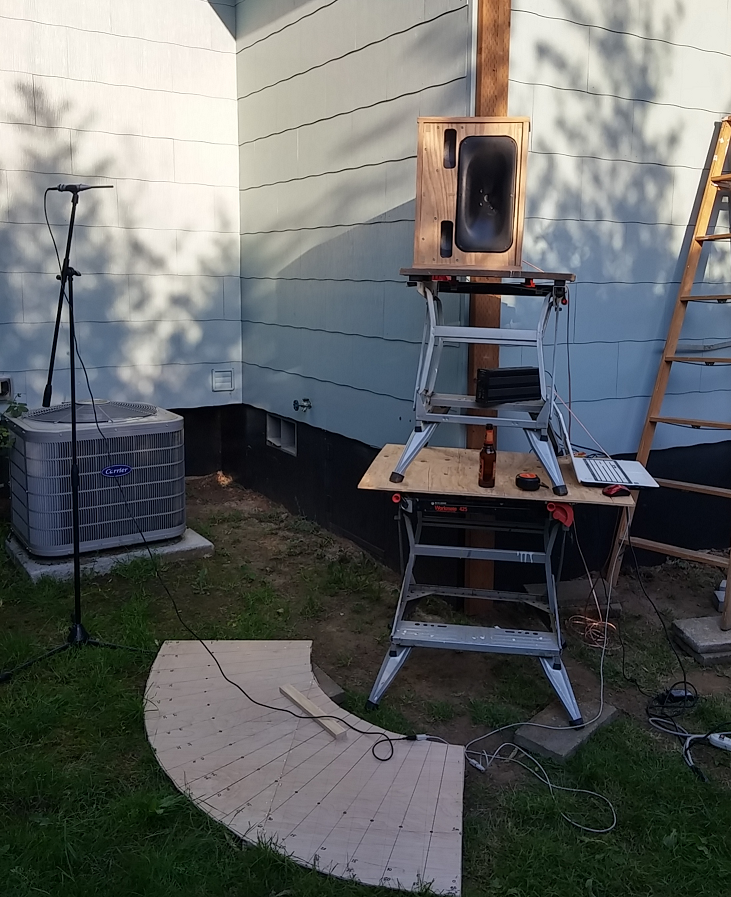
The jist of saying all this is that the measurements shown earlier were made in a somewhat cramped basement, so they don't go very low in frequency and have some unavoidable reflection interference....
An externally hosted image should be here but it was not working when we last tested it.
Looks like there's an anechoic chamber in Portland, might be worth a look : Research on hearing loss ramps up on multiple fronts press | OregonLive.com
Vance Dickason lives south of Portland, I wonder if this is where he does his measurements for Voice Coil magazine?
Yeah, the wax and varnish used is low viscosity so it will wick up in between the laminations.
Vacuum is used if you need absolutely all air pockets removed; a must for HV applications.
Hmmmm....I wonder if some thin CA glue would work for bonding the laminations together thru wicking action?
This would be a fair amount of work, but you could do the following:
1) stick the inductor in one of those bags for sealing food
2) Vacuum out the air with a FoodSaver*
3) Put epoxy into the bag using a syringe. If you're careful, no are will get into the bag
It's a lot of rigmarole, but I think it would be airtight.
* everyone should have a foodsaver, greatest kitchen item ever
Id love to do one with a seos24 loaded with a Aurasound whisper driver.

Here's a frequency response and distortion plot for an Aurasound Whisper mounted on a waveguide that I 3D printed for my car. The blue line is the Whisper's response in "free air", with the back sealed off. The red curve is on the waveguide I made.
I really dig the Aurasound Whisper, but I don't think it's possible to get it to play to 20khz on a horn or waveguide. The problem is that you get a dip and a peak in the octave of 10-20khz. I don't think this is a problem related to the geometry of the horn; I think what's happening is that the Whisper on a flat baffle will "beam", and when it beams, the energy is focused *forward* into a narrow lobe. When you put the Whisper on a waveguide you get a dip around 12,000hz, and then the output comes back up.
I think the rise above 12,000hz is caused by a resonance in the driver.
When they design compression drivers, they design them so that the resonance in the diaphragm adds constructive output in the top ocatve. You can see this in a CSD plot.
In a nutshell, if it wasn't for that high frequency resonance, the response of the compression driver and the Whisper would look closer to a bandpass filter.
It's easier to see this behavior if you look at some 'raw' measurements of compression drivers, particularly at the CSD. Augerpro has published some good ones here. My measurement above is from one of my threads at diyma.
At long last I got outside to do some measurement on the final crossover. Been delayed by lack of a space (needed to wait till shared driveway was clear), illness (again, but not serious.... germs seem to like me), and a visit by daughter and toddler grandson (a week here, preceded by a week toddler-proofing the house). I don't know how I ever had time to have regular employment.
Anyway, here is the outdoor setup:

I wanted to make measurements as fair as I could, with a real wall behind the speaker as it was designed to be used. I did put the speaker up about 65 inches above the hard concrete to try to avoid reflection effects from that.
Here is a plot of the horizontal response curves, every 5 degrees from 0 to 90

That's an unsmoothed plot, full disclosure worst case, and you can see it gets pretty ripply on the way-off-axis curves because of reflections off the garage wall behind it when the mic gets over there, and from diffraction off the cabinet edges.
You can also see the deep quarterwave reflection notch due to the space between the baffle and the back wall.
Here it is again with only the 0 to 45 degree curves, also unsmoothed:
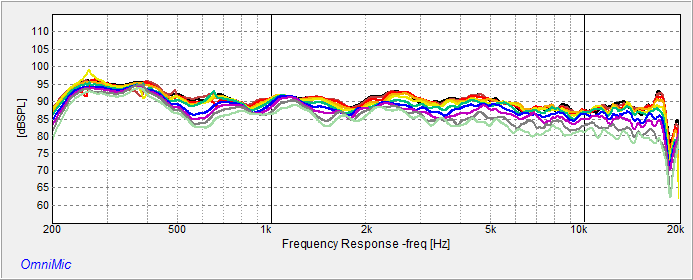
Here are the same two graphs but done with "ERB" smoothing (which is supposed to mimic the smoothing done by human hearing's Equivalent Rectangular Bandwidth, to better resemble the audble effects:
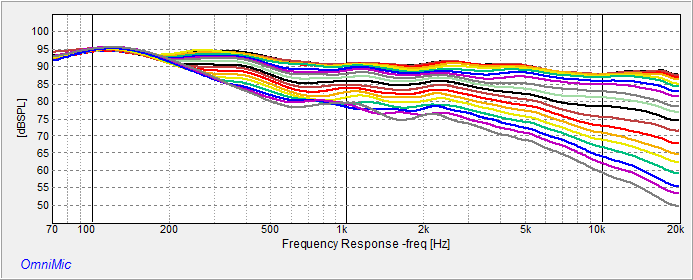

Looking pretty good, if I do say so myself.
Anyway, here is the outdoor setup:

I wanted to make measurements as fair as I could, with a real wall behind the speaker as it was designed to be used. I did put the speaker up about 65 inches above the hard concrete to try to avoid reflection effects from that.
Here is a plot of the horizontal response curves, every 5 degrees from 0 to 90

That's an unsmoothed plot, full disclosure worst case, and you can see it gets pretty ripply on the way-off-axis curves because of reflections off the garage wall behind it when the mic gets over there, and from diffraction off the cabinet edges.
You can also see the deep quarterwave reflection notch due to the space between the baffle and the back wall.
Here it is again with only the 0 to 45 degree curves, also unsmoothed:

Here are the same two graphs but done with "ERB" smoothing (which is supposed to mimic the smoothing done by human hearing's Equivalent Rectangular Bandwidth, to better resemble the audble effects:


Looking pretty good, if I do say so myself.
Vertical curves
Next up, some vertical response curves. First the "going upwards" curves, 5 degrees per step again to 90 degrees off axis, in unsmoothed and ERB smoothed versions:

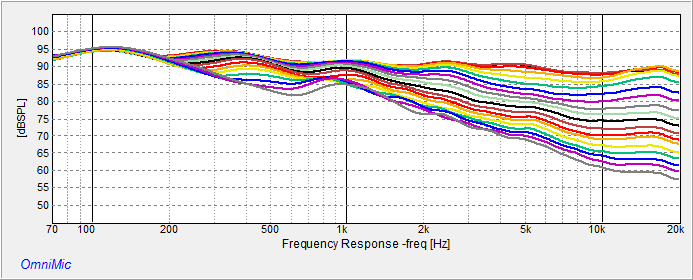
No lobes worth mentioning (at least not until getting toward 80 degrees of axis), so that's good.
Here are the same curves for "going downwards":
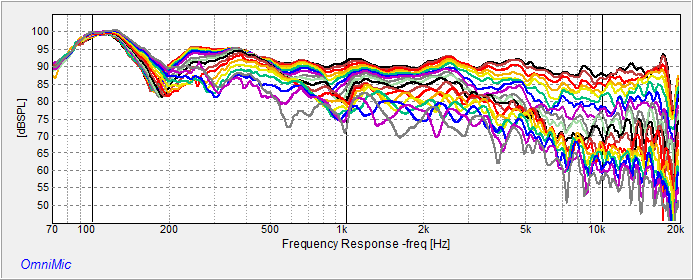
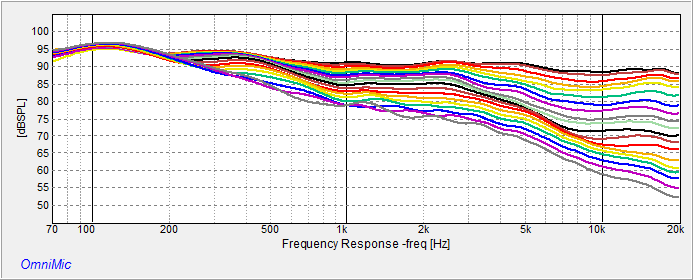
That one is downright pretty. There's no vertical directivity to speak of below about 2.5kHz, of course, but the trend is a nice rolloff.
Here are some of the color plots of the patterns, unsmoothed and ERB (these are un-normalized).
Horizontal:

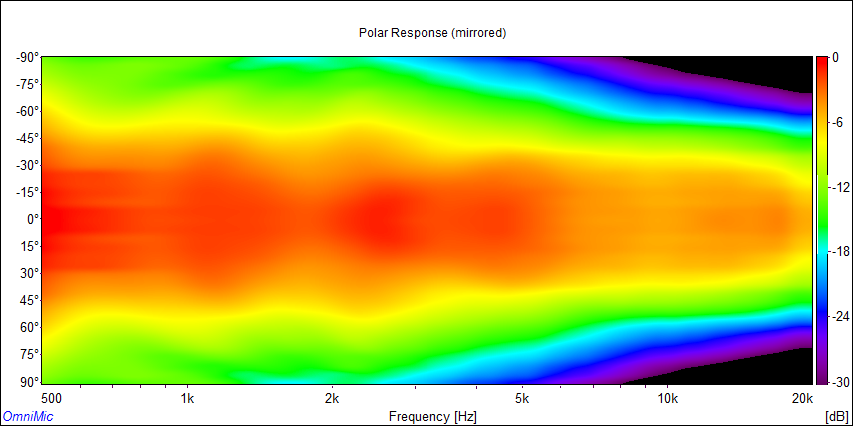
The horn is nominally 90 degrees (+/-45). The apparent narrowing at higher frequencies is actually just because of the response curve used (rolling off toward HF rather than flat, which seemed a bit too bright to me). Directivity below about 800Hz comes from the spaced slot-fed woofers.
Vertical (nominal 40 degrees down to 2500Hz):


Not as pretty, but about what can be expected with a horn of this dimension. Still, rather well behaved (look at polars from "normal" speakers sometime!) and they play beautifully in a room, without looking like audio nut speakers!
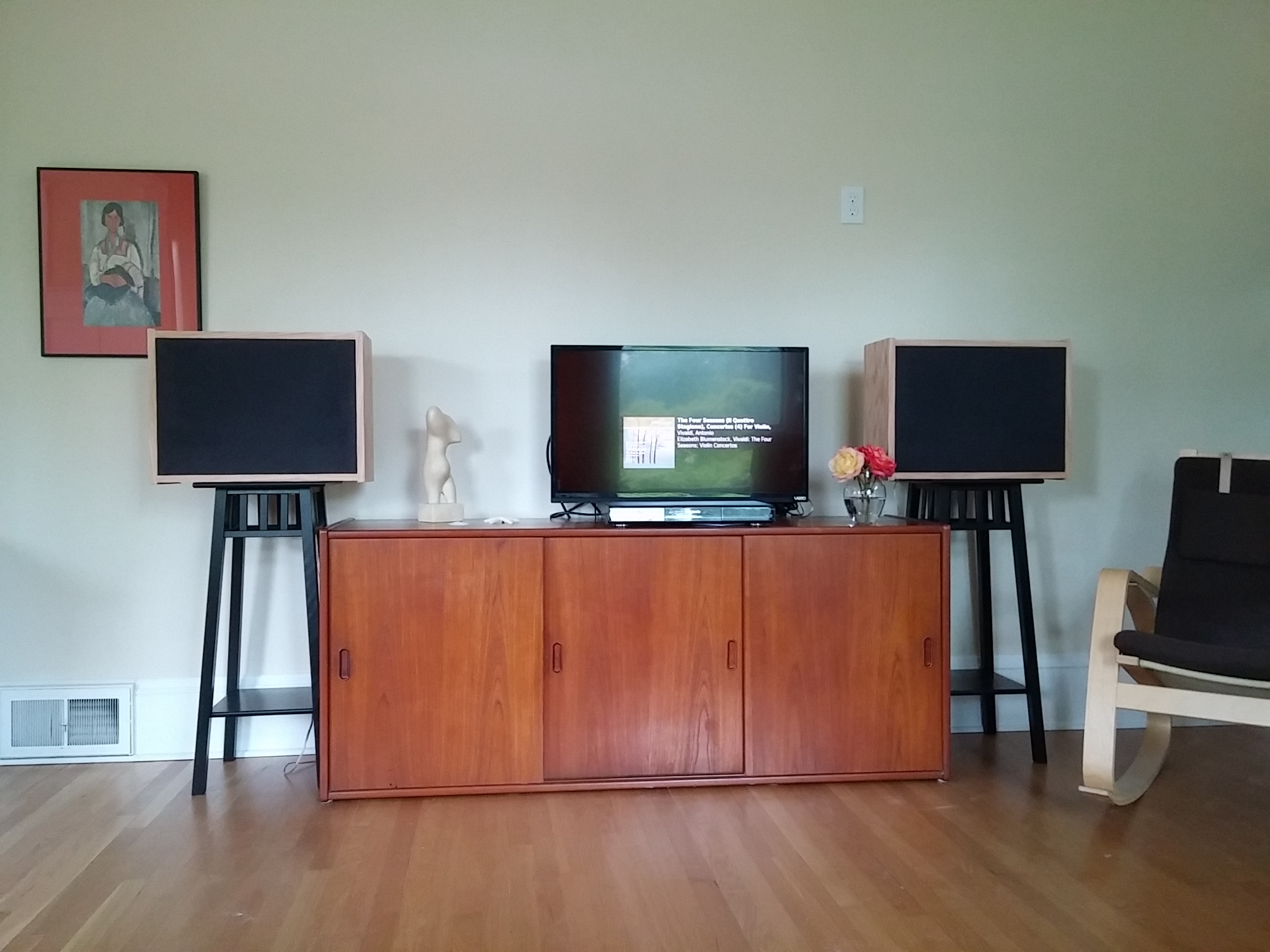
(that'a s 32" video screen shown)
Next up, some vertical response curves. First the "going upwards" curves, 5 degrees per step again to 90 degrees off axis, in unsmoothed and ERB smoothed versions:


No lobes worth mentioning (at least not until getting toward 80 degrees of axis), so that's good.
Here are the same curves for "going downwards":


That one is downright pretty. There's no vertical directivity to speak of below about 2.5kHz, of course, but the trend is a nice rolloff.
Here are some of the color plots of the patterns, unsmoothed and ERB (these are un-normalized).
Horizontal:


The horn is nominally 90 degrees (+/-45). The apparent narrowing at higher frequencies is actually just because of the response curve used (rolling off toward HF rather than flat, which seemed a bit too bright to me). Directivity below about 800Hz comes from the spaced slot-fed woofers.
Vertical (nominal 40 degrees down to 2500Hz):


Not as pretty, but about what can be expected with a horn of this dimension. Still, rather well behaved (look at polars from "normal" speakers sometime!) and they play beautifully in a room, without looking like audio nut speakers!

(that'a s 32" video screen shown)
Last edited:
Last measurement of the day, a distortion sweep. The level is between about 97dBSPL (at bass frequencies) and 90dBSPL (treble frequencies). It gets to about -40dB (1% 2nd harmonic) around 450Hz, but stays around -50dB elsewhere when above 150Hz. Gets to about 3% at 100Hz as the low end starts to roll off. 3rd Harmonic is very nice and low through most of the band.

(sorry for the long/skinny plot, forgot to reformat it)

(sorry for the long/skinny plot, forgot to reformat it)
I'll probably give the design details (crossover and how to attach the midrange to the horn) in blog form so it doesn't get easily lost. I did a minimum/linear phase FIR EQ (with a Linkwitz transform type LF boost since it's being used without a subwoofer), will post the miniDSP files for that in the blog, too. Will try to do a video of a square-wave sweep using that when I work out how I did that before. 😡
I'm starting in on a shelf-ported version next. I just got a new (to me, actually very old) table saw for that project. I made the mistake of leaving the fence from my old saw outside and it seems to have been stolen (ah, city life!). But the new saw has a MAGNIFICENT fence on it, is belt-drive, and is wide enough for up to 42 inch panels, so I think it all worked out well and didn't cost much. (A table saw isn't really needed at all to make the SmallSyns, but will certainly make it easier.... and who doesn't like power tools??)
I'm starting in on a shelf-ported version next. I just got a new (to me, actually very old) table saw for that project. I made the mistake of leaving the fence from my old saw outside and it seems to have been stolen (ah, city life!). But the new saw has a MAGNIFICENT fence on it, is belt-drive, and is wide enough for up to 42 inch panels, so I think it all worked out well and didn't cost much. (A table saw isn't really needed at all to make the SmallSyns, but will certainly make it easier.... and who doesn't like power tools??)
- Home
- Loudspeakers
- Multi-Way
- Small Syns
